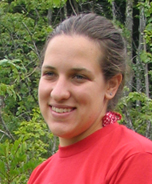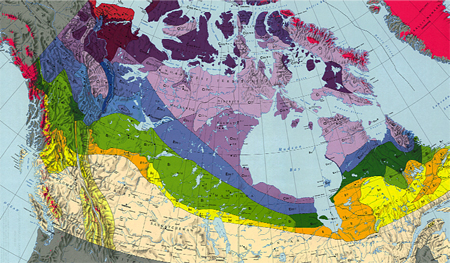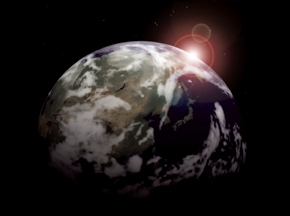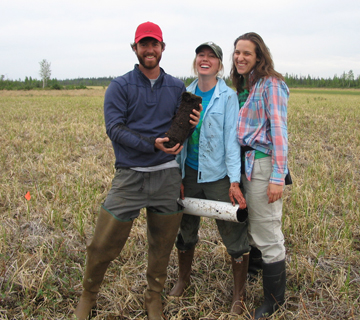Bomb Detection
Graduate student Claire Treat wins a big federal fellowship to investigate the “great northern carbon bomb"
 |
|
| Claire Treat Photo: K.Donahue, UNH-EOS |
|
Treat, who is wrapping up her fourth year as an intern/fellow in the joint UNH-NASA Research and Discover program, will use the generous DOE fellowship to fund her Ph.D. research in the university’s interdisciplinary Natural Resources and Earth System Science program beginning next fall.
The DOE letter notifying Treat of her award reads, “Your selection is in recognition of your outstanding academic accomplishments, graduate education and research objectives, and recommendation letters – all of which reflected your potential for important professional contributions to the mission of the DOE Office of Science.”
It could be argued that Treat’s Ph.D. research objectives are indeed important well beyond the mission of the DOE Office of Science. The title of her proposal for the department’s fellowship program was “Future of soil carbon in permafrost regions: The great northern carbon bomb?”.
The potential bomb is the prodigious amount of organic carbon that has remained locked up in permafrost for millennia but is now at risk of being unleashed due to the rapid warming of Earth’s northern climes. “Bomb” is hardly hyperbolic; permafrost soils in boreal and Arctic ecosystems store almost twice as much carbon as is currently present in the atmosphere.
But scientists only know these ecological systems are poised on precarious physical and chemical thresholds and could very suddenly play a very big role in additional climate change. Or not. The systems could get wetter and release more methane or drier and release less. They could thaw and have all the soil carbon potentially respire and thus become a big carbon dioxide source, or they could become more productive and forests could move in and become CO2 sinks. They could even shift from one of these responses to another over a couple of decades.
It’s a big, unnerving unknown that Treat hopes her research will help clarify to some extent. For her project she will gather a variety of soil samples from sites in Alaska, incubate them and mimic various environmental conditions in a lab setting, then measure the subsequent release of carbon.
“My research will investigate the interactions between soil organic carbon and permafrost thaw in northern ecosystems – black spruce forest, birch/aspen forest, peatland, and tundra – under wet, moderate or dry soil conditions, which are all predicted with climate change,” Treat explains. She adds, “Complex responses to changes in water-table and soil temperature have been documented in a few field studies, but little is known about the relative rates of decomposition of organic material – dead things – within the soil and the subsequent release of carbon following permafrost thaw in most northern ecosystems, including black spruce forests, aspen forests, and tundra.”
But it will be a complex puzzle to unravel because the effects of melting permafrost on soil carbon storage will vary across ecosystems due to differences in soil organic layer thickness, carbon “quality” (i.e., carbon that is easily released from decomposing vegetation versus carbon that is more tightly bound chemically), and ecosystem response to changes in soil moisture.
“In the lab, comparing controls on soil organic carbon mineralization – the process of decomposition – and permafrost degradation across ecosystems will allow me to evaluate changes in soil organic storage, potential net CO2 and methane emissions, and resulting radiative forcing under future climate scenarios,” Treat says.
 |
|
| "Canada - Permafrost" from National Atlas of Canada, 5th edition. Courtesy Natural Resourses Canada, 1995. |
Says Treat, “The reason we should care about this is that the impact of climate change is already being seen up in Alaska and northern regions. They’ve had changes in snowpack and a big change in growing season length, and the largest temperature increase on an annual basis has occurred there. So there is the potential that a huge positive feedback system could be set in motion.”
For her Research and Discover fellowship work, Treat, along with her advisor, research associate professor Steve Frolking, and research scientist Dominik Wisser, both of the Complex Systems Research Center (CSRC), has been doing computer modeling of soil temperatures and active layer thickness of permafrost in boreal peatlands (which may or may not contain permafrost). Her DOE fellowship project will extend and enhance this work; she will take her results from the lab study to determine the relative rates of carbon release from different ecosystems under wetter and drier conditions and apply that to the model.
"Basically,” she notes, “I’ll use the results from my laboratory experiment to indicate the sensitivity of carbon stored in northern soils with the predicted climate change. There could be large or small carbon emissions from these soils – we don't really know. This is important because it may affect the rate of subsequent change within these ecosystems and the ecosystem response to further changes in permafrost.”
Treat will also be working in Alaska with CSRC’s Wil Wollheim, co-director of the Water Systems Analysis Group, investigating how changing seasonality in the Arctic is affecting nutrient release and uptake in tundra stream ecosystems.
Treat explains, “With the climate warming, decomposition and subsequent release of nitrogen will happen for more of the year, including during the winter season when plants can’t take up nutrients, and that could mean an influx of nitrogen into streams. This will affect stream productivity as well as nutrient availability for plants. If the nitrogen is lost to streams, it won't be available for plants to take up.” She will carry this work over to her DOE fellowship project by analyzing her soil cores for the release of nitrogen in addition to carbon.
Treat believes her Research and Discover experience was a key part of her ultimate success in winning the DOE fellowship – both in terms of the high-level research she has been able to conduct on a related topic and the freedom from standard graduate student teaching duties the R&D program provides.
“I have a friend at another university who hasn’t gotten a lot done on her research because of her teaching demands,” she says.
Treat, who says she chose UNH for graduate study because of the Research and Discover program, will move seamlessly from one rich fellowship to another. The DOE Office of Science Graduate Fellowship Program will provide Treat with a maximum three-year award of $50,500 per year so she’ll be able to put all her focus into detection work on the potential great northern carbon bomb.
by David Sims, Science Writer, Institute for the Study of Earth, Oceans, and Space. Published in Summer 2010 issue of EOS .

